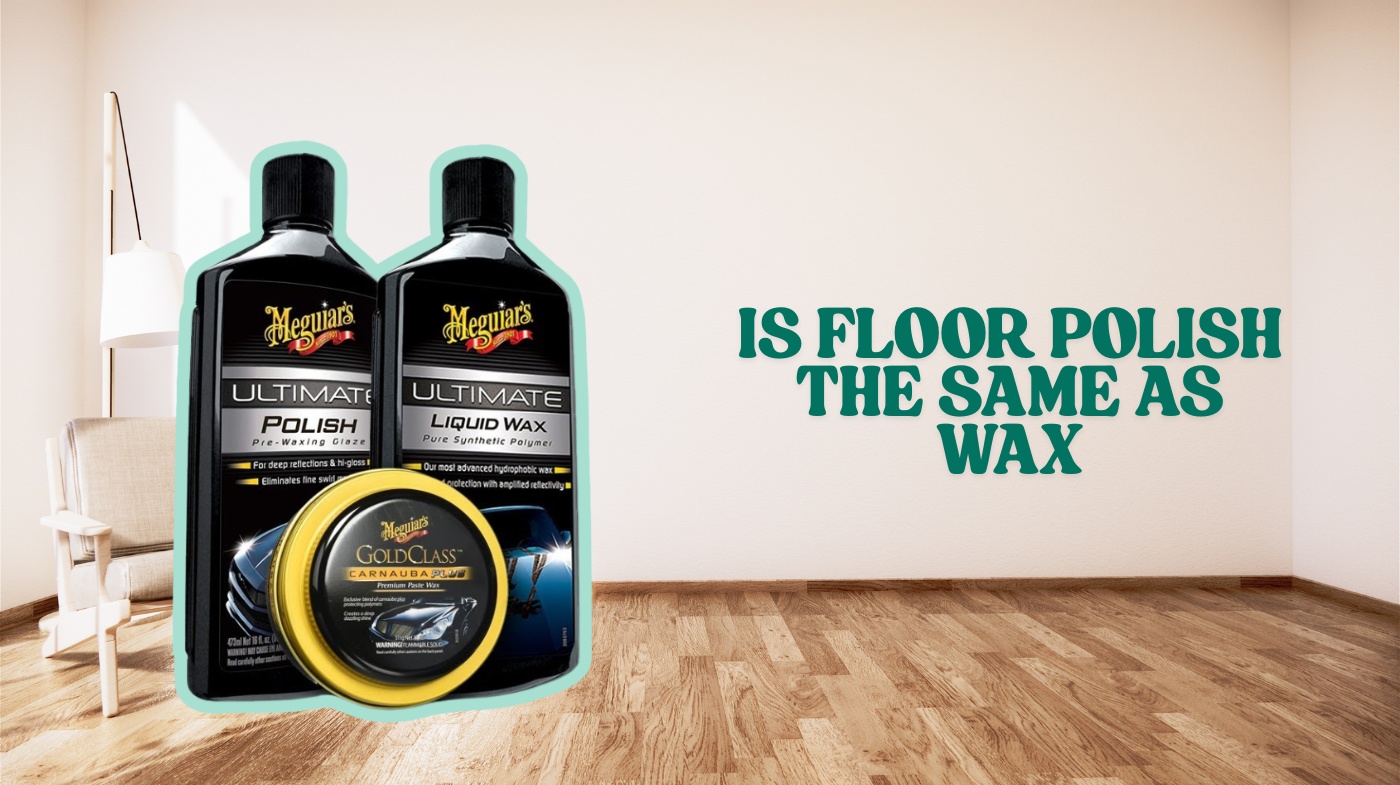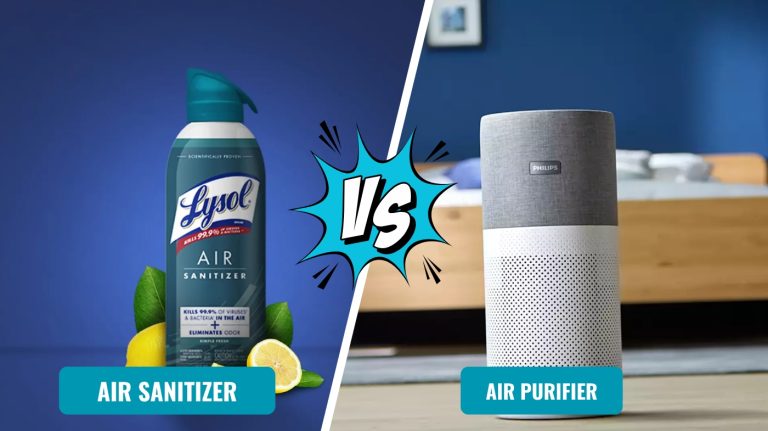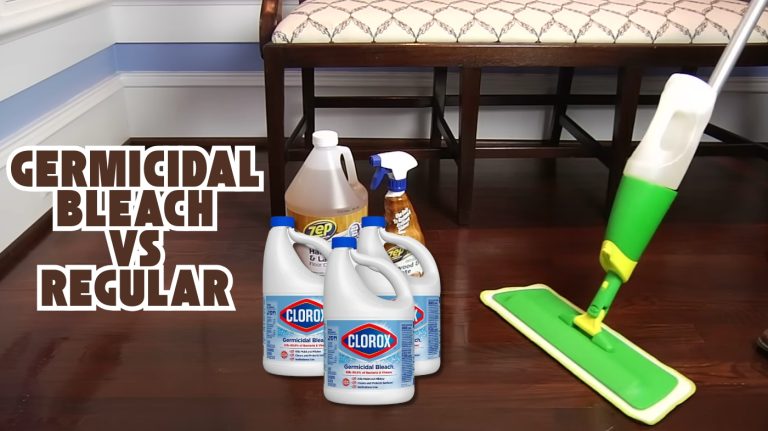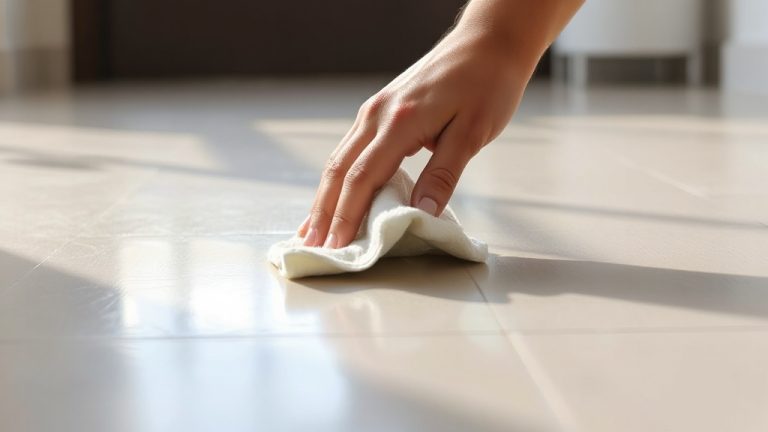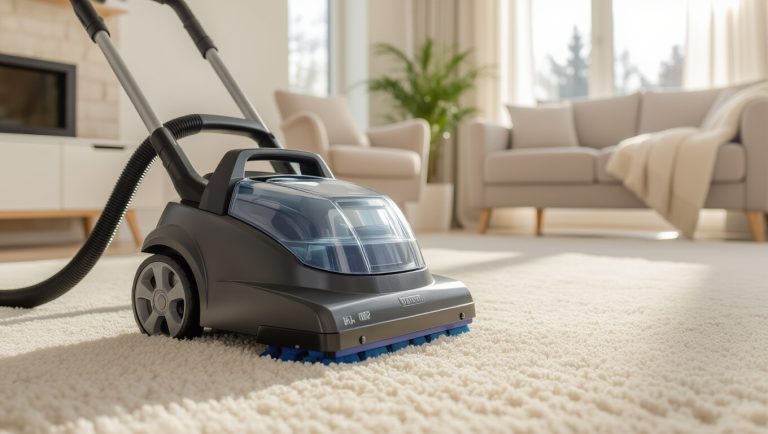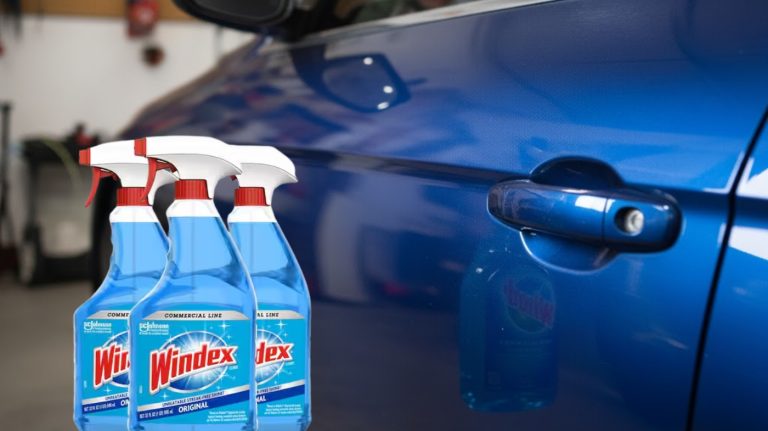Is Floor Polish the Same as Wax: Know the Real Difference
You’re not dealing with the same product when comparing floor polish to wax. Floor polish forms a hard, synthetic polymer layer that offers durable gloss and abrasion resistance, ideal for vinyl, laminate, and tile.
Wax uses natural ingredients to create a softer, water-resistant barrier perfect for sealing and protecting wood surfaces. Their application, texture, and maintenance differ considerably.
If you want to optimize your floor care strategy, understanding their unique roles and how they complement each other will prove invaluable.
Key Takeaways
- Floor polish and wax are different; polish forms a hard synthetic coating, while wax creates a softer protective layer using natural ingredients.
- Wax is ideal for natural wood due to its moisture resistance and ability to preserve texture, whereas polish suits synthetic floors like vinyl and laminate.
- Polish dries quickly without buffing, restoring shine by smoothing surface imperfections, whereas wax requires buffing for a glossy, resilient finish.
- Polish offers greater durability and abrasion resistance for high-traffic areas, while wax provides gentler protection for delicate or low-traffic wood floors.
- Combining polish and wax can enhance floor shine and protection, creating a durable barrier suitable for hardwood, vinyl, and some tile floors.
The Purpose of Floor Polish and Wax
Floor polish and wax serve distinct but complementary roles in floor care, each designed to enhance and protect surfaces in specific ways.
Floor polish primarily improves a floor’s appearance by adding shine and sealing the surface to increase durability. It also enhances slip resistance when applied correctly, making floors safer and easier to maintain by preventing dirt from embedding.
Additionally, polished floors can boost property value and workplace morale by presenting a clean, professional environment. Regular polishing also protects flooring from wear and tear, extending the lifespan of floors even under heavy use.
Floor polish enhances shine, seals surfaces for durability, improves slip resistance, and promotes a clean, professional look.
Floor wax, on the other hand, forms a protective layer that guards against scratches, spills, and moisture damage, while providing a glossy, reflective finish. Regular waxing extends floor lifespan and simplifies cleaning by repelling dirt.
Both products contribute to long-term floor protection but focus on slightly different aspects of care and maintenance.
Key Differences in Composition and Ingredients
You’ll notice that wax primarily relies on natural components like carnauba and beeswax, which contribute to its softer, more pliable finish.
In contrast, floor polish incorporates synthetic polymers that create a harder, more durable film on surfaces. The polymer properties determine crucial attributes such as gloss, hardness, and toughness of the finish.
These compositional differences directly affect the texture and longevity of the finish you achieve.
Wax Natural Components
Although waxes come in various forms, natural components like carnauba, beeswax, and montan wax define the fundamental composition of traditional floor waxes.
These natural waxes provide a protective, glossy finish while enhancing durability and water resistance.
Here are the key natural wax components you’ll find:
- Carnauba Wax – Sourced from Brazilian palm trees, it offers exceptional gloss and hardness.
- Beeswax – Known for its water resistance and natural protective properties.
- Montan Wax – Extracted from lignite, it adds durability and improves finish quality.
Understanding these natural components helps you appreciate floor wax’s classic appearance and eco-friendly benefits compared to synthetic alternatives. Floor wax typically contains natural waxes like beeswax and carnauba wax, which contribute to its water-resistant layer and protective qualities.
Polish Synthetic Polymers
Natural waxes like carnauba and beeswax provide traditional floor finishes with protective qualities, but modern polishes achieve durability and performance through synthetic polymers.
Polishes primarily form hard, transparent films from acrylic polymers, sometimes enhanced with urethane for toughness.
These engineered polymer networks create chemically crosslinkable coatings that resist wear, chemicals, and water better than natural waxes. For example, DURAGREEN™ 4373 uses a unique cross-linking technology to achieve a high gloss finish without relying on zinc.
Synthetic wax emulsions in polishes serve mainly as lubricants to improve buffability and slip resistance without compromising film hardness. Precise ratios of copolymers such as styrene-acrylic blends balance flexibility and toughness, preventing brittleness.
The result is a fast-drying, scuff-resistant finish with consistent gloss and easier maintenance. Unlike wax, polishes rely on these advanced synthetic ingredients to deliver superior protective performance in high-traffic environments.
Finish Texture Differences
When comparing floor polish and wax, their finish textures stem directly from distinct compositions and key ingredients.
Wax contains natural elements like carnauba wax, offering a hard, durable, and moisture-resistant barrier that softens floor appearance. This natural wax is particularly valued for its durability and moisture resistance in various climatic conditions.
Polish relies on synthetic compounds such as acrylic polymers and alkali-soluble resins, creating a smooth, shiny, and versatile finish.
Key finish texture differences include:
- Durability and Texture: Wax forms a resilient, slightly softened protective layer; polish provides a sleek, glossy surface.
- Application and Maintenance: Wax needs buffing and lasts longer; polish applies easily but requires frequent reapplication.
- Protective Qualities: Wax excels in moisture and scratch resistance, while polish balances protection with enhanced shine.
How Floor Polish and Wax Affect Floor Appearance?
Since floor polish and wax serve different purposes, understanding how each affects your floor’s appearance is essential for achieving the desired finish.
Floor polish dries quickly to a clear, non-waxy shine without buffing, restoring luster by smoothing minor surface imperfections and locking in essential oils to prevent drying or cracking.
In contrast, floor wax requires buffing to develop a glossy, resilient finish that fills scratches and grooves, creating a softer, more even look.
Wax forms a durable protective layer, ideal for maintaining long-lasting shine in high-traffic areas, whereas polish provides a superficial shine that may require more frequent application.
For floors that endure heavy use, professionals often recommend a strip and wax approach to restore and protect the finish thoroughly.
Choosing between them depends on your need for durability versus ease of application and the specific aesthetic you want to maintain on your floors.
Suitable Surfaces for Polish Versus Wax
You’ll find floor wax works best on natural surfaces like wood and cork, providing durable protection and a strong seal.
On the other hand, floor polish suits synthetic materials such as vinyl and linoleum, offering a quick, easy shine without heavy sealing. Floor polish is a clear liquid that locks in essential oils to protect surfaces from drying and cracking.
Natural Surfaces and Wax
Although both polish and wax serve to enhance and protect natural surfaces, they differ greatly in suitability depending on the material.
Wax provides a durable protective barrier ideal for high-traffic areas, while polish mainly improves appearance with a shinier finish but less durability.
When choosing between wax and polish for natural surfaces, consider:
- Wood Floors: Wax offers superior protection and enhances wood grain with a subtle sheen; polish brightens but wears faster. Polishing also helps to restore natural glow without adding layers, making it a good option for regular maintenance.
- Stone and Concrete: Wax seals surfaces like marble or concrete against moisture and scratches, extending lifespan.
- Bamboo and Cork: Wax preserves natural texture and offers water resistance, making it preferable over polish.
Applying wax requires buffing but yields longer-lasting results, whereas polish applies easily but demands frequent reapplication.
Synthetic Surfaces and Polish
When maintaining synthetic surfaces, choosing the right treatment is essential to preserve their durability and appearance.
Synthetic floors like luxury vinyl planks, laminate, and polyurethane-coated surfaces benefit from specific polishes designed for their non-porous, waterproof nature. Wax is generally unsuitable, as it can leave residues and damage these materials.
You should apply polish formulated for synthetic floors to enhance scratch resistance and maintain gloss without compromising the surface.
Additionally, synthetic flooring materials often feature low maintenance properties that make proper care easier. Before application, guarantee thorough cleaning and verify product compatibility with your floor type.
The frequency of polishing depends on foot traffic and wear. Using the correct polish extends the life of your synthetic flooring while avoiding issues caused by inappropriate wax use, making polish the preferred choice for these modern, resilient surfaces.
Application Techniques for Polish and Wax
Since proper application directly impacts the durability and appearance of floor treatments, understanding the distinct techniques for applying polish and wax is crucial.
Proper application techniques are essential for maximizing the durability and appearance of floor treatments.
When applying polish, start by thoroughly cleaning and drying the floor. Use pH-neutral formulas with a clean mop or lint-free rag, then buff to enhance shine. It is important to use the correct machine speed to avoid floor damage and achieve the best results.
Wax application requires thin, even layers applied with a mop or applicator on a clean surface. Multiple coats may be necessary, followed by buffing for smoothness.
- Prepare the floor by cleaning and drying to guarantee adherence and avoid sealing dirt.
- Apply polish or wax with appropriate tools—mops or rags—using thin, even strokes.
- Buff the surface post-application to remove imperfections and enhance gloss.
Maintenance and Reapplication Frequency
Because maintaining floor polish and wax is essential for preserving both appearance and durability, you need to establish a regular maintenance schedule tailored to your flooring type and usage conditions.
Hardwood floors typically require waxing every 6-8 months, while tile and concrete need stripping and waxing every 6-12 months.
Vinyl and linoleum demand more frequent attention, often quarterly. High-traffic areas such as commercial spaces may necessitate reapplication every 3-6 months. This frequency is influenced by factors such as the type of flooring and amount of daily foot traffic.
Monitor foot traffic, environmental factors, and budget constraints to adjust your schedule accordingly. Incorporate regular cleaning, inspections, and scrub-and-recoat procedures to extend intervals between intensive stripping and waxing.
This proactive approach optimizes resource use, maintains floor integrity, and prevents premature wear, ensuring your floors remain both functional and visually appealing over time.
Longevity and Protective Qualities
You’ll find that floor polish offers a more durable finish than wax, especially under heavy foot traffic, due to its synthetic acrylic or urethane base.
Wax, on the other hand, creates a softer, protective layer ideal for natural wood by filling in surface imperfections.
LTP Clear Wax provides a dazzling shine and strong resilient layer, protecting surfaces from water, dirt, dust, and common household contaminants, making it suitable for a variety of natural stone and wood floors.
Durability Comparison
When evaluating floor treatments, you’ll find that wax outperforms polish in durability and protective qualities, especially under heavy use.
Wax is designed to withstand high-traffic conditions, providing a longer-lasting finish that resists moisture and abrasion better than polish. It also offers superior scratch resistance, maintaining floor integrity even in demanding environments.
Historically, wax was the preferred finish for maintaining the natural look of hardwood floors and is still favored in older, classically styled homes.
Consider these key points:
- Longevity: Wax requires less frequent reapplication, reducing maintenance time and costs.
- Moisture and Chemical Resistance: Wax creates a resilient barrier against spills and cleaning agents, unlike polish.
- Traffic Tolerance: Wax better absorbs wear from foot traffic, protecting floors from scratches and abrasions.
Choosing wax guarantees enhanced durability and extended floor life in areas subject to heavy use.
Protective Layer Differences
Understanding the differences in protective layers between floor wax and polish helps clarify their respective longevity and protective qualities.
Wax, often containing natural ingredients like carnauba and beeswax, penetrates deeply into wood, providing durable, water-resistant protection that can last years with proper maintenance. It softens varnished floors’ appearance while extending their lifespan and filling grooves to guard against scratches.
Conversely, polish, composed mainly of acrylic polymers and urethane, forms a hard, transparent coating ideal for synthetic surfaces and high-traffic areas.
Though polish offers strong resistance to chemical spills and restores floor luster, it typically requires more frequent reapplication. However, many polishes, especially those used on ESD floors, lose their conductivity over time, leading to ineffective static control once the polish deteriorates.
Both require upkeep, but wax’s deep penetration and natural composition offer superior moisture defense and long-term elegance, while polish excels in shine and surface hardness.
Impact on Floor Durability and Wear Resistance
Although floor polish can enhance the appearance of your floors, it generally offers less durability and wear resistance compared to wax.
Floor polish boosts shine but lacks the durability and protection that wax provides.
Wax acts as a stronger sealant, filling grooves and protecting against scratches, moisture, and abrasion. This means wax-treated floors endure heavy foot traffic better and require less frequent maintenance.
Many users recommend sealing surfaces prior to applying polish or wax to maximize protection and adhesion for longer-lasting results surface preparation.
Here are three key points to take into account:
- Durability: Wax provides a protective layer that extends floor lifespan, while polish wears down quickly, especially in high-traffic areas.
- Wear Resistance: Wax resists scratches and moisture, maintaining surface integrity longer than polish.
- Maintenance Frequency: Polish demands frequent reapplication, increasing long-term costs, whereas wax’s longevity reduces upkeep needs.
Choosing Between Polish and Wax Based on Floor Type
Selecting the right floor treatment depends largely on the type of flooring you have, as each material responds differently to polish and wax.
For wood floors, wax is ideal—it penetrates the surface, sealing and enhancing natural warmth while filling micro-grooves to reduce scratches.
Synthetic or resilient floors, like vinyl and laminate, require polish; its acrylic base forms a hard, transparent layer that resists wear and restores shine without buffing.
Stone, tile, and concrete also benefit from polish, which enhances gloss and protects without absorption.
In high-traffic areas, polish withstands abrasion better, whereas low-traffic or delicate wood floors gain from wax’s softer, longer-lasting protection.
Choose wax for porous, soft surfaces and polish for non-porous, hard floors to optimize durability and appearance.
Combining Polish and Wax: When and Why
When you combine polish and wax, you create a synergistic effect that enhances both the shine and durability of your floors. This method is especially effective for high-traffic areas or restoration projects where enhanced protection and aesthetics are essential.
The combination forms a robust barrier, improving wear resistance and prolonging floor life.
Consider these key reasons to combine polish and wax:
- Enhanced Shine and Protection: Delivers a vibrant, long-lasting glossy finish while defending against scratches.
- Floor Type Suitability: Best for hardwood, vinyl, and certain tile floors, but avoid on urethane-sealed laminates.
- Maintenance Efficiency: Creates a smooth surface that simplifies cleaning and reduces upkeep frequency. This protective layer also resists dust and stains, making routine cleaning quicker and easier.
Applying thin layers and allowing proper drying guarantees peak performance and avoids buildup.
Frequently Asked Questions
Can Floor Polish or Wax Cause Allergies or Respiratory Irritation?
Think of floor polish and wax as a double-edged sword: they protect your floors but might irritate you. Both can contain chemicals that trigger allergies or respiratory irritation, especially if you’re sensitive to VOCs or additives.
Polish often has synthetic compounds, while wax uses natural or chemical ingredients, so reactions vary. To minimize risks, you should always use gloves, masks, and guarantee good ventilation during application.
Are There Eco-Friendly or Non-Toxic Options for Floor Polish and Wax?
Yes, you can find eco-friendly, non-toxic floor polishes and waxes. Look for polishes made from natural oils like jojoba or olive oil, which are water-based and low in VOCs, reducing indoor pollution.
For waxes, options like carnauba and beeswax are plant-based and biodegradable. Water-based emulsions like BioShield Wax offer protection without harsh chemicals.
Always check for renewable ingredients and test samples to guarantee safety and performance for your floors.
How Do Temperature and Humidity Affect the Drying Time of Polish and Wax?
Temperature and humidity tightly tune the timing of drying. When temperatures climb, polish and wax dry faster due to increased evaporation and chemical activity.
Cooler climates cause slower setting, extending your application time. High humidity hinders evaporation, delaying drying, especially for polish, which forms a harder coat less easily in moist air.
Wax, more water-resistant, withstands humidity better but still slows down. Aim for 60°F–80°F and low humidity for swift, smooth results.
Can Pets Slip More Easily on Waxed or Polished Floors?
You’ll find pets slip more easily on waxed floors, especially when the wax is freshly applied and lacks slip-resistant additives.
Wax tends to create a slick surface, increasing accident risks. Polished floors, however, are designed to be slip-resistant and meet safety standards like ADA and OSHA.
What Are the Best Tools for Removing Old Wax or Polish Buildup?
To remove old wax or polish buildup effectively, use plastic scrapers or credit cards for gentle scraping without damaging surfaces.
Steam cleaners soften wax, making removal easier, especially with microfiber pads. For residue, soft scrub brushes work well. Chemically, opt for floor wax removers or pH-neutral cleaners. Always test products on a small area first.
Wear gloves and goggles, clear the workspace, work patiently, and dry the floor thoroughly afterward to prevent damage.
Bright Rooms Start with the Right Floor Care Decision
Now that you know floor polish and wax serve different purposes, it’s interesting that polished floors can reflect up to 40% more light, enhancing room brightness considerably.
Choosing the right product depends on your floor type and desired finish—polish offers a smooth, durable shine, while wax provides deeper protection with a warmer look.
Applying them correctly prolongs floor life and maintains appearance, so pick wisely for ideal results.

